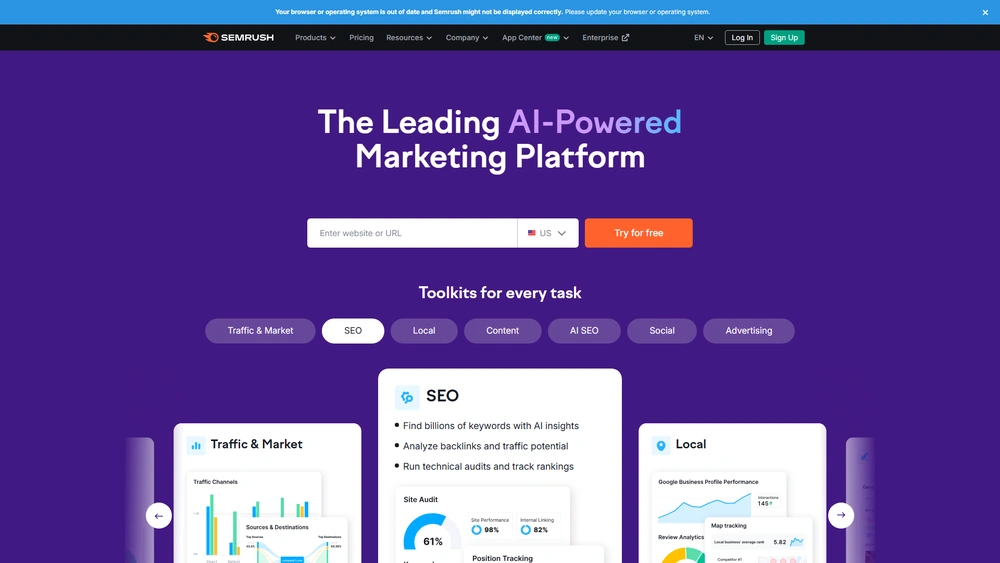SEMrush Overview & 2025 Industry Position
SEMrush has cemented its position as a global leader in digital marketing intelligence. Originally recognized for deep SEO capabilities, the platform has expanded to offer end-to-end marketing solutions, serving over 10 million users across 140 countries. In 2025, SEMrush remains a go-to platform for marketers looking to leverage AI-powered insights, multi-channel data, and strategic performance dashboards that rival enterprise tools—at SMB-friendly prices.
From Launch to 2025: SEMrush’s Journey
Created in 2008 by a small group of SEO professionals, SEMrush launched as a keyword research tool for organic search. It rapidly evolved into a broad marketing suite, introducing features like backlink auditing (2010), competitor analysis (2013), and multi-channel content tracking (2016). With the 2018 release of SEMrush Projects, it became more than a toolkit—it became a centralized marketing command center.
Recent milestones include:
- 2020: IPO launched on the NYSE under the ticker SEMR.
- 2021: Acquired Prowly (PR management) and Backlinko (content education).
- 2022: Introduced “ContentShake” AI writing assistant.
- 2023: Launched Marketplace for on-demand content writing.
- 2024: Integrated intent-based AI keyword clustering driven by SERP behavior.
The 2025 strategy: Position SEMrush as the decision intelligence platform for modern marketers, blending real-time analytics with collaborative planning tools.

SEMrush Key Features
SEMrush delivers an integrated suite of tools spanning search, content, social, and advertising. Key features include:
- Keyword Magic Tool: Discover millions of keyword variations with intent filters.
- Site Audit: Deep SEO crawl and health diagnostics with Core Web Vitals integration.
- Position Tracking: Precise SERP rank tracking across devices and locations.
- Traffic Analytics: Competitor and industry benchmarking data.
- App Center: Access to 50+ partner apps including ChatGPT SEO plugins and AI audits.
- ContentShake AI: AI-assisted content generation for blogs, landing pages, and outreach.
- Lead Generation Widget: Client-ready reports tailored for marketing agencies.
Workflow & UX
The SEMrush user interface has improved dramatically in 2025, emphasizing ease of use and onboarding:
- Clean Navigation: Intuitive left panel separates tools by marketing category.
- Task Management: SEMrush Projects include timelines, alerts, and integrations with task boards.
- Data Panels: Customizable widgets with click-to-drill analytics.
- Reports Library: Dozens of preset templates, now customizable with AI-driven annotations.
Pro Tip: Use SEMrush’s “Projects” dashboard to monitor multiple campaigns across clients or departments—it lets you centralize reports and alerts into one view.
SEMrush Pricing Analysis & Value Metrics
As of July 2025, SEMrush offers three main plans with varied features and user allowances.
| Plan | Monthly | Key Features |
|---|---|---|
| Pro | $139.95 | 5 projects, 500 keywords, site audit for 100k pages |
| Guru | $249.95 | 15 projects, historical data, content marketing tools |
| Business | $499.95 | 40 projects, API access, white-label reports |
Value Summary: SEMrush remains highly cost-effective for agencies and marketing teams seeking broad visibility, especially at the mid-tier “Guru” level with enhanced content and historical tools.
Competitive Landscape
SEMrush holds its own in 2025 among a competitive field of digital marketing tools. Here’s a quick comparison:
| Tool | Key Strength | Best For |
|---|---|---|
| Ahrefs | Backlink index strength | SEO specialists |
| Moz | Simplified SEO tools | Small teams |
| SpyFu | Affordable PPC insights | Startups |
| Sprout Social | Social reporting | Social-first teams |
Ideal Use Cases for SEMrush
- Agencies: Multiclient dashboards, white-label reporting, and client portals.
- In-house Marketing Teams: Access to a unified SEO, PPC, and content suite.
- eCommerce Brands: Product keyword tracking, listing optimization, competitor benchmarking.
- Freelancers: Flexible project plans, report exports, and AI-assisted copywriting.
SEMrush Integrations Ecosystem
SEMrush in 2025 features over 80 prebuilt integrations across categories:
- CMS: WordPress, Shopify, Wix
- Analytics: Google Analytics 4, Looker Studio
- CRM: HubSpot, Salesforce
- Content/Outreach: Trello, Asana, Mailchimp
- AI Tools: GPT SEO Assistants, Jasper, SurferSEO
Pros & Cons
- Pros:
- Best-in-class keyword and domain analysis
- Multi-tool ecosystem in one login
- Automated site audits and content scoring
- Cons:
- Steep learning curve for new users
- Higher tiers may be overkill for sole proprietors
- Cost adds up with extra users or add-on apps
Final Thoughts
SEMrush hits the 2025 market as more than a marketing tool—it’s a strategic operating system for growth-minded businesses. The depth of insights and integration options make it ideal for agencies and teams needing unified, AI-enhanced data across every performance touchpoint. While it demands time to master, the platform consistently delivers strong ROI.
SEMrush FAQ
SEMrush is used for SEO, PPC, content marketing, competitor analysis, and website performance tracking—all in one dashboard.
Yes, especially the Pro plan, which offers robust features for SEO and content planning on a budget.
Yes, including AI-powered content generation and keyword clustering tools built into the platform or via partner apps.
Yes, SEMrush offers ad keyword planning, competitor PPC analysis, and cost-per-click metrics.
SEMrush Academy offers free training and certifications for SEO, content, and digital strategy professionals.